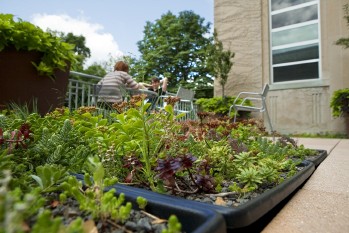CAMPUS LIFE
Lawns grow long and roofs go green in effort to cut campus costs

To cut mowing costs and naturalize campus landscapes, planners have let the grass below the Johnson Art Museum grow into meadow. See larger image
As Cornell becomes more sustainable -- and cuts costs -- Cornellians are seeing fewer lawns and more meadows on campus, longer grass and more green roofs and functional plantings.
At the same time, Cornell's landscape planners are working to naturalize the look and feel of central spaces, maintain such familiar historical gardens as those around the A.D. White House and support the long-standing tradition of using the landscape as an extended research and teaching classroom.
Landscape designers also are "relying more and more on endowments and gifts" to manage spaces, says David Cutter, landscape architect for Planning, Design and Construction at Cornell's Facilities Services.
Such open-space initiatives are written into the Comprehensive Master Plan for the Ithaca Campus, which has "a very strong landscape focus," says Cutter. As Cornell develops and grows, "we need to make sure such development fits into a larger landscape plan."
Cornell's campus combines both urban (managed by the Grounds Department) and country settings (managed by Farm Services and the Cornell Plantations), and the landscape varies from gorges, greens and gateways to quads, streets and walkways. Each setting requires an integrated management plan, Cutter adds.

The Susan A. Henry Garden Terrace is part of a green roof on top of Mann Library. See larger image
Naturalization and sustainability have been central themes that run throughout the landscape plan. For example, the Grounds Department plans to include plantings between curbs and sidewalks to enhance aesthetics, purify water and reduce storm runoff and pollution into Cayuga Lake, as well as supplement tree-root systems.
Similarly, Kroch Library, the Cornell Store, several West Campus buildings, Weill Hall and Mann Library all have green roofs. The Susan A. Henry Garden Terrace on the Mann Library rooftop is edged with 2-by-2-foot trays with sedum plant varieties growing in lightweight gravel, which reduces weeds and mimics sedum's native rocky alpine environment. The plantings insulate the building from heat, limit sun and heat damage, extend the roof's life and reduce water runoff.
Landscape planners have also naturalized the Wee Stinky Glen that runs diagonally across campus from Beebe Lake past the A.D. White House, between Sage and Day halls, and on to West Campus and Llenroc. Planners used the storm water disposal stream "to replicate the aesthetics of a natural creek," says Cutter.
The Grounds Department has also cut costs by raising its mower blades to allow lawns to grow to four inches, which extends the grass-root systems; because grass won't grow much longer, it reduces the need to mow as often. And researchers are currently testing sustainable, low-maintenance fescue grasses on the steep slope behind Uris Library. The turf is being developed by Cornell researchers in plots near Game Farm Road.
Campus planners have also identified key little-used spaces, mostly on the edges of campus but also below the Herbert F. Johnson Museum of Art, where the grass has been left to grow into meadow.